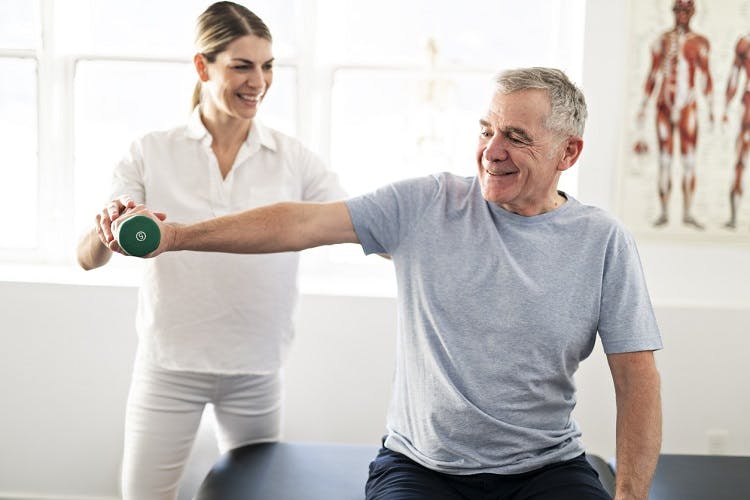Today we’re answering a common question that we get from our readers and neurorehabilitation device users: “What matters more: repetition or consistency?”
To put it more specifically: Should you prioritize repetition or consistency as you work on improving functions affected by stroke, brain injury, spinal cord injury, or cerebral palsy? Let’s find out.
How Does Repetition Promote Recovery?
Repetition is arguably the most important element of neurological recovery. This is because it sparks neuroplasticity, which is the brain’s mechanism of rewiring itself and strengthening frequently used pathways.
When a thought or action is practiced with high repetition (aka, massed practice), specific neurons in the brain fire. The more these neurons fire together, the stronger they wire together.
The brain likes to be efficient. When an action is practiced frequently, the brain responds by creating and strengthening neural pathways responsible for that movement. The stronger these pathways become, the easier they are to execute.
For example, if you want to improve your ability to walk and move your legs, it’s a good idea to practice leg rehabilitation exercises. When these leg movements are repeated with high repetition, it sparks neuroplasticity and creates/strengthens neural pathways responsible for moving your legs.
This begs the question: would it be better to do 700 repetitions of leg exercises once a week or 100 repetitions every day? This is what our reader asked in regards to FitMi, our home therapy device that helps improve mobility after neurological injury:
“I have your FitMi and I use it for an hour a day. But I only exercise one muscle group for that hour, because more repetition is better right? Or should I be exercising all the muscle groups in that hour? But wouldn’t that be less effective because it’s less repetition per muscle group?”
It brings up an excellent point. Which is better: more repetition or more consistency?
Why Does Consistency Matter?
Consistency is another staple of recovery. Because the brain likes to be efficient, it prioritizes neuroplasticity based on how consistently a function is used. The more we practice a specific activity, the more the brain will adapt to execute that activity with greater ease.
Let’s use the same example with leg exercises. If you practice your leg exercises once per week, you are not stimulating the brain the rest of the week. During that “down time,” those pathways may not become as strong as they would if the activity were practice every day.
Think of it like building muscles: if you lifted weights once per week, you wouldn’t get as strong as you would if you lifted weights every day, even at a lower intensity.
You can also think of it like growing a plant. If you only water a plant once per week, it would begin to wilt throughout the rest of the week as its neglected. The same goes for neurological recovery.
When you work on building new neural pathways through rehabilitation exercise, the brain needs constant stimulation to help reinforce and strengthen neurological connections.
You won’t always need to practice leg exercises every day for the rest of your life, though. Once you reach a point where you have recovered enough function, moderate exercise will help keep those neural connections strong and healthy.
What Happens If You Don’t Participate in Therapy Consistently?
This begs another question: what happens if you don’t participate in therapy with consistency?
The first thing that would happen is slower results. When you fail to reinforce new neural connections with massed practice, you won’t see the fastest results possible.
And in extreme cases — like giving up rehabilitation altogether — you can actually regress and lose some of the progress you’ve made.
Remember, the brain likes to be as efficient as possible. If you aren’t using the new connections you’re forming, you’ll lose them. And if those connections are not well-enforced to begin with, they are more susceptible to weakening from neglect.
That’s where the saying “use it or lose it” comes from. It’s a popular neurorehab saying because it succinctly describes the importance of moving your body.
Even if you are recovering from paralysis and cannot move your body on your own, it’s important for someone (like a trained caregiver or therapist) to help you move your body through its range of motion. This helps keep the brain stimulated and discourages further loss of movement.
All movement is beneficial during recovery because it helps stimulate the brain.
What Matters More: Repetition or Consistency?
During neurological recovery, many individuals are building pathways from scratch. When part of the brain or spinal cord is damaged, neuroplasticity allows healthy areas of the brain to take on lost functions.
However, neuroplasticity needs your help in order to maximize recovery. First, focus on accomplishing high repetition of therapeutic exercises. Then, make sure you’re practicing those exercises on a consistent basis.
Exercising a body part just once a week does not provide enough reinforcement. Better results occur when an exercise is practiced consistently.
Also, exercising one muscle group for an entire hour would be considered overexercising, which is something you want to avoid during recovery. See the guidelines for exercise after stroke for more details.
If you’re a FitMi user, we recommend using it for 30 minutes a day. You have the ability to target specific muscles groups (the hand, arm, leg, or core), and we recommend targeting all your desired muscle groups in that half hour.
For example, if you want to improve arm and leg function, don’t just do 30 minutes of arm exercises one day and 30 minutes of leg exercises the next day. Instead, you can find consistency by targeting both the arm and leg for 15 minutes each during your daily workout.
As you can see from FitMi’s reviews, many individuals see results within days or weeks of using FitMi. This is because it helps you accomplish an enormous amount of repetition and it also motivates you to exercise with consistency. These are two keys to recovery.
The Verdict
The answer to the original question is that both repetition and consistency matter. Repetition helps create new neural connections and consistency helps strengthen those connections.
The more repetitions you perform, the more you will activate neuroplasticity — just don’t sacrifice consistency for more repetition. You can benefit more from exercising a muscle group for 10 minutes every day than for 1 hour once a week.
We hope this article helped inspire you to develop consistency with your home therapy program. And if you struggle with that, consider motivating yourself with interactive rehab equipment like FitMi.











